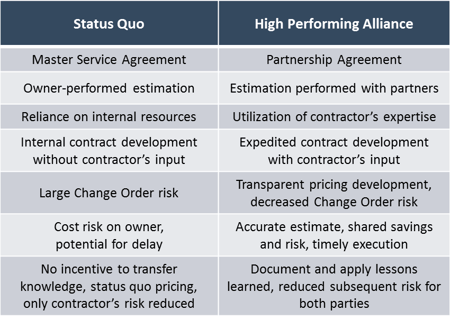Midstream firms with large capital programs must balance many competing priorities, from cost and schedule to quality and safety.
Many of the most sophisticated firms are resolving those challenges through alliance contracting, a form of contracting based on building long-term, strategic relationships with key partners.
In today’s post, we’ll share the value of an alliance partnership vs. a traditional contracting relationship and give 6 specific steps to implementing a successful partnership.
Alliance Contracting vs. Traditional Contracting
While typical owner-contractor relationships are often transactional in nature, High Performing Alliances are instead based on long-term relationships (typically >3 years) wherein resources, risks and rewards are shared between the owner and its contractors.
The below figure highlights key additional differences between the two approaches:

Because alliance partnerships are predicated on the sharing of resources, knowledge, risk, and reward, they can be instrumental in enabling midstream firms to improve the performance of their new build and maintenance projects. By aligning incentives between the owner and the contractor, alliance partnerships drive:
- Continuous productivity improvements
- Schedule adherence
- Quality of work
- Improved accountability
- Cost effectiveness
- Superior safety performance
- Improved planning accuracy
- Enhanced construction execution
- And more...
Driving Success through Alliances
While High Performing Alliances promise extraordinary value for midstream projects, execution requires a deep commitment on the parts of both the Owner and contractors and a managing framework that serves the needs of each party.
To establish a successful alliance, we recommend the following 6 steps:
1. Develop Open Book Pricing Options: An open book policy sets clear guidelines for the level of transparency required from partners in order to establish a productive baseline for the alliance.
2. Structure Risk/Reward Sharing Program: Enabling risk-reward sharing mitigates risk and incentivizes contractors to aim for cost savings. Co-developed pricing models help in evaluating incentive/penalty options.
3. Customize Contract Terms and Conditions: Contractual language creates the structure and guidelines for all aspects of project execution. These terms need to be explicit and firm, while also allowing for the flexibility to handle the dynamic nature of executing large capital projects.
4. Conduct and Manage RFP Process: Alliance contracts require close working relationships between the project owner and contractors. This requires extensive vetting to be performed during the RFP stage to ensure selection of an appropriate Contractor.
5. Negotiate Contract Terms and Pricing: Sophisticated negotiation strategies ensure that owners will be able to establish and maintain advantageous pricing and drive cost savings over time. Before entering into alliance agreements, firms should negotiate using scenario analysis and market benchmarks. It is also critical to establish key functional and performance metrics in order to set up the relationship for success.
6. Implement Contract Management Strategy: Alliance contracts typically involve new forms of working relationships for each of the parties involved, so internal processes may need to be re-built to streamline project execution from design engineering through performance management. For example, we often recommend that firms develop customized project toolkits to track project progress including change orders, milestones, schedule, invoicing, cost true-up, etc.
Interested in learning more about the steps to implementing a High Performing Alliance? Click here to contact our project experts.
